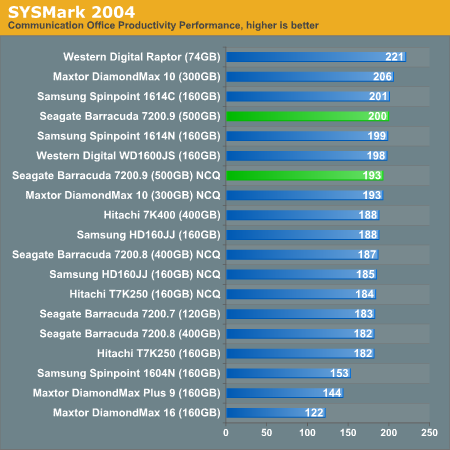Seagate 7200.9 500GB: Mouthwatering Benchmarks
by Purav Sanghani on October 24, 2005 12:05 AM EST- Posted in
- Storage
Overall System Performance - SYSMark 2004
SYSMark 2004 is divided into two separate suites: Internet Content Creation and Office Productivity. What makes SYSMark an ideal hard disk benchmark is that its scores are totals of response times, meaning that the benchmark measures how long the system takes to respond to a task (e.g. how long before a search and replace is completed after it is initiated) and sums up all such response times to generate a score. This score is generated for six total subcategories: three under Internet Content Creation and three under Office Productivity.
For the most part, SYSMark is CPU/platform bound, but we will see some variations in performance according to disk speed; at the same time, there are a couple of benchmarks within SYSMark that are heavily disk dependent.
Internet Content Creation Performance
Our results showed very little difference in the performance of the competitors; not enough to rule out margin of error in the Content Creation part of SYSMark 2004. The scores for the majority of drives landed between 180-183, which does not show too well the drive that performs better than the others.
Office Productivity Performance
SYSMark's Office Productivity suite consists of three tests, the first of which is the Communication test. The Communication test consists of the following:
SYSMark 2004 is divided into two separate suites: Internet Content Creation and Office Productivity. What makes SYSMark an ideal hard disk benchmark is that its scores are totals of response times, meaning that the benchmark measures how long the system takes to respond to a task (e.g. how long before a search and replace is completed after it is initiated) and sums up all such response times to generate a score. This score is generated for six total subcategories: three under Internet Content Creation and three under Office Productivity.
For the most part, SYSMark is CPU/platform bound, but we will see some variations in performance according to disk speed; at the same time, there are a couple of benchmarks within SYSMark that are heavily disk dependent.
Internet Content Creation Performance
Our results showed very little difference in the performance of the competitors; not enough to rule out margin of error in the Content Creation part of SYSMark 2004. The scores for the majority of drives landed between 180-183, which does not show too well the drive that performs better than the others.
Office Productivity Performance
SYSMark's Office Productivity suite consists of three tests, the first of which is the Communication test. The Communication test consists of the following:
"The user receives an email in Outlook 2002 that contains a collection of documents in a zip file. The user reviews his email and updates his calendar while VirusScan 7.0 scans the system. The corporate web site is viewed in Internet Explorer 6.0. Finally, Internet Explorer is used to look at samples of the web pages and documents created during the scenario."











46 Comments
View All Comments
Spacecomber - Monday, October 24, 2005 - link
The results from these benchmarks were about as mouthwatering as a rice cake with nothing on it.jeffrey - Monday, October 24, 2005 - link
Titling the article "Mouthwatering Benchmarks" and then reading the mid-pack performance lowers the author's credibility.The drive is big, but it uses lower density plattters, has the highest idle heat, has the highest heat under load, and is 2.6 decibels louder than a 10Krpm Raptor when transferring. Overall performance was mid-pack and not mouth watering.
****************************************************
It would have been a solid review without the title.
Much better than recent video card reviews.
****************************************************
ss284 - Monday, October 24, 2005 - link
Pretty dissapointing figures considering all the marketing crap that was posted a couple weeks back as a full fledged preview on anandtech. The drive neither runs cooler or quieter or faster than the previous generation of drives. Other than the 5 year warranty this drive has nothing over a model from a competing manufacturer, most notably hitachi. Im also suprised that the 160 gb model wasnt tested, since it has 160 gb platters, instead of the 125 in the 500gb model.LoneWolf15 - Monday, October 24, 2005 - link
One other thing that it has over Hitachi: Seagate (along with WD and Maxtor) offer advance replacement in the event of failure. Hitachi, unfortunately, does not.It may sound like a minor gripe, but if I'm trying to save a client's data off a failing drive, it's nice to have the replacement drive handy. Since I've also had a drive company lose a drive on me in the RMA process (not a common occurrence, but I've had it happen) I feel far more secure having advance replacement. I do agree though that performance specs are not as good as expected; the difference is small enough that I'd save money and buy the previous Seagate 7200.8 drives.
smn198 - Monday, October 24, 2005 - link
Please benchamrk the 160GB modelPenth - Monday, October 24, 2005 - link
"you're better off working with a 15K RPM Raptor for now."I think you meant 10K RPM Raptor, unless WD just dropped a bomb.
First Post.